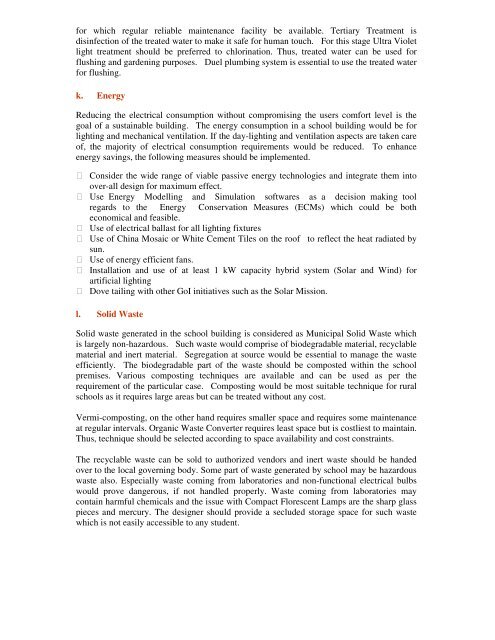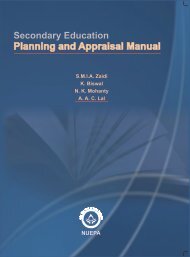Download File
Download File
Download File
You also want an ePaper? Increase the reach of your titles
YUMPU automatically turns print PDFs into web optimized ePapers that Google loves.
for which regular reliable maintenance facility be available. Tertiary Treatment is<br />
disinfection of the treated water to make it safe for human touch. For this stage Ultra Violet<br />
light treatment should be preferred to chlorination. Thus, treated water can be used for<br />
flushing and gardening purposes. Duel plumbing system is essential to use the treated water<br />
for flushing.<br />
k. Energy<br />
Reducing the electrical consumption without compromising the users comfort level is the<br />
goal of a sustainable building. The energy consumption in a school building would be for<br />
lighting and mechanical ventilation. If the day-lighting and ventilation aspects are taken care<br />
of, the majority of electrical consumption requirements would be reduced. To enhance<br />
energy savings, the following measures should be implemented.<br />
Consider the wide range of viable passive energy technologies and integrate them into<br />
over-all design for maximum effect.<br />
Use Energy Modelling and Simulation softwares as a decision making tool<br />
regards to the Energy Conservation Measures (ECMs) which could be both<br />
economical and feasible.<br />
Use of electrical ballast for all lighting fixtures<br />
Use of China Mosaic or White Cement Tiles on the roof to reflect the heat radiated by<br />
sun.<br />
Use of energy efficient fans.<br />
Installation and use of at least 1 kW capacity hybrid system (Solar and Wind) for<br />
artificial lighting<br />
Dove tailing with other GoI initiatives such as the Solar Mission.<br />
l. Solid Waste<br />
Solid waste generated in the school building is considered as Municipal Solid Waste which<br />
is largely non-hazardous. Such waste would comprise of biodegradable material, recyclable<br />
material and inert material. Segregation at source would be essential to manage the waste<br />
efficiently. The biodegradable part of the waste should be composted within the school<br />
premises. Various composting techniques are available and can be used as per the<br />
requirement of the particular case. Composting would be most suitable technique for rural<br />
schools as it requires large areas but can be treated without any cost.<br />
Vermi-composting, on the other hand requires smaller space and requires some maintenance<br />
at regular intervals. Organic Waste Converter requires least space but is costliest to maintain.<br />
Thus, technique should be selected according to space availability and cost constraints.<br />
The recyclable waste can be sold to authorized vendors and inert waste should be handed<br />
over to the local governing body. Some part of waste generated by school may be hazardous<br />
waste also. Especially waste coming from laboratories and non-functional electrical bulbs<br />
would prove dangerous, if not handled properly. Waste coming from laboratories may<br />
contain harmful chemicals and the issue with Compact Florescent Lamps are the sharp glass<br />
pieces and mercury. The designer should provide a secluded storage space for such waste<br />
which is not easily accessible to any student.




